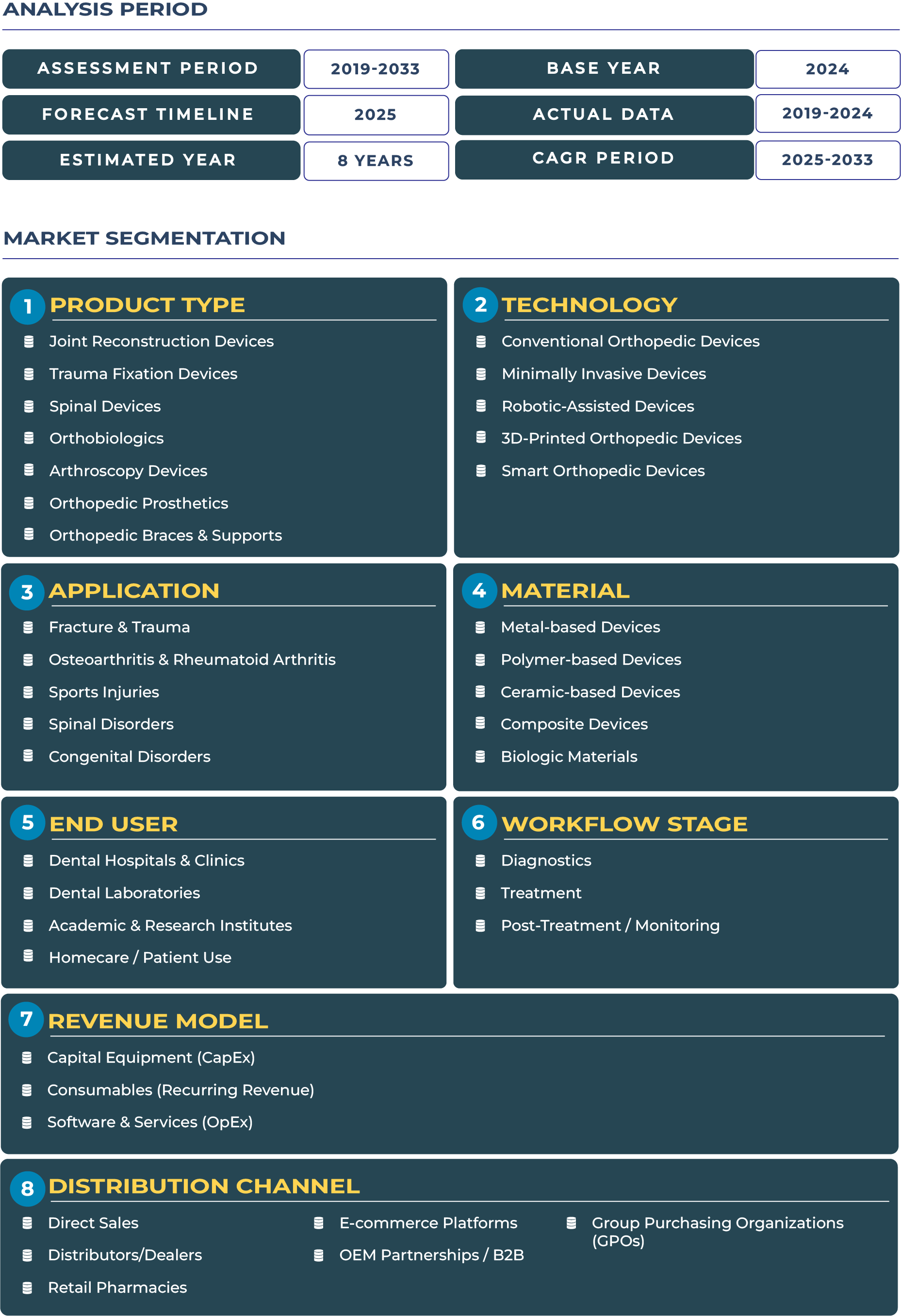Australia Orthopedic Devices Market Outlook: Australia Orthopedic Devices Market Set for Accelerated Growth Through Public-Private Synergy
Australia’s healthcare system, structured around a dual model of universal public coverage and a robust private insurance sector, provides a balanced framework for orthopedic innovation. This structure ensures broad access to essential orthopedic interventions while also enabling premium adoption of advanced implants and minimally invasive technologies in private hospitals. The orthopedic devices industry in Australia benefits from this equilibrium, with government-led initiatives ensuring equitable trauma care and private insurers supporting higher-value adoption of technologies such as robotic-assisted joint replacements and spinal implants. This ecosystem supports long-term resilience and positions Australia as a strong growth market in the Asia-Pacific orthopedic devices sector.
The Australian orthopedic devices market is projected to expand from USD 895.1 million in 2025 to USD 1,732.4 million by 2033, reflecting a CAGR of 8.6% from 2025 to 2033. This strong trajectory is underpinned by an aging population with higher incidence of musculoskeletal conditions, particularly hip and knee osteoarthritis, and trauma-related injuries from sports and road accidents. Australia’s strong per-capita healthcare spend supports widespread adoption of premium orthopedic implants, while its advanced private hospital ecosystem enables faster integration of cutting-edge devices such as spinal fusion systems and arthroscopy solutions. However, rising healthcare expenditure pressures in the public sector create an ongoing need for value-based procurement models. Despite these constraints, the orthopedic devices landscape in Australia remains resilient, benefitting from stable political governance, an attractive investment climate, and a healthcare system increasingly open to technological innovation.
Drivers and Restraints: Structural Factors Defining Australia Orthopedic Devices Ecosystem
Aging demographics and strong private healthcare networks strengthen device adoption
One of the primary growth drivers in Australia Orthopedic Devices sector is its rapidly aging population. According to the Australian Institute of Health and Welfare, musculoskeletal conditions remain among the leading causes of disability, driving demand for hip and knee reconstruction devices. Complementing this is Australia’s robust private hospital network, where orthopedic surgeons have early access to advanced technologies such as minimally invasive joint reconstruction devices and orthobiologics. High per-capita healthcare expenditure further strengthens adoption, ensuring a market environment conducive to both local and international orthopedic device manufacturers.
Geographic disparities, regulatory pathways, and pricing pressures restrain growth
Despite strong growth potential, the orthopedic devices industry in Australia faces significant barriers. Geographic remoteness in rural provinces limits timely access to trauma fixation and prosthetic devices, widening the urban-rural care gap. Complex regulatory approval timelines under the Therapeutic Goods Administration (TGA) and strict reimbursement listing under the Pharmaceutical Benefits Scheme (PBS) often delay market entry for innovative implants. Moreover, public hospitals operate under price-sensitive procurement frameworks, limiting rapid adoption of premium orthopedic prosthetics and advanced spinal devices. These challenges require companies to innovate with cost-efficient solutions and explore novel distribution models.
Trends and Opportunities: Technological Integration and Regional Outreach Shaping the Future of Orthopedics
Ambulatory surgical centers and tele-rehab reshape orthopedic patient pathways
Ambulatory Surgical Centers (ASCs) are gaining traction across major cities such as Sydney, Melbourne, and Brisbane, driving higher case throughput for orthopedic procedures. These centers demand device solutions that align with rapid recovery and cost-effectiveness, creating opportunities for trauma fixation and arthroscopy device manufacturers. Another major trend is tele-rehabilitation adoption, which gained momentum post-pandemic. Tele-rehab platforms enable follow-up care for joint reconstruction and spinal device patients, especially in remote regions, making orthopedic care more accessible and cost-efficient. Additionally, private insurers are actively negotiating value-based models that link device reimbursement to patient outcomes, further shaping procurement strategies.
Opportunities in ASC-focused bundles, tele-rehab integration, and rural orthopedic outreach
The orthopedic devices industry in Australia presents compelling opportunities for companies that align their strategies with systemic shifts. Manufacturers are now bundling product offerings tailored for ASC environments, integrating trauma fixation kits and joint reconstruction devices with training programs. Tele-rehab integration solutions that combine orthopedic prosthetics and digital monitoring platforms are poised for strong uptake. Furthermore, Key Opinion Leader (KOL)-led outreach programs targeting rural hospitals are bridging geographic care gaps by training surgeons in advanced spinal and trauma care solutions. These initiatives create pathways for companies to expand their footprint beyond urban centers while reinforcing their role in equitable healthcare delivery.
Competitive Landscape: Strategic Collaborations and Localized Solutions Accelerate Growth in Australia Orthopedic Devices Sector
The competitive landscape of the Australian orthopedic devices market is shaped by global players such as Smith+Nephew, Johnson & Johnson, and Zimmer Biomet, alongside domestic innovators like Austofix. In 2024, several international players partnered with private hospital chains to introduce robotic-assisted knee and hip replacement systems, while local manufacturers expanded trauma fixation exports within the Asia-Pacific region. Strategies gaining traction include targeting ASCs with bundled solutions, piloting tele-rehab programs in rural hospitals, and offering leasing models for capital-intensive devices such as navigation-enabled spinal systems. These approaches combine affordability with technological innovation, ensuring sustainable growth in a market where public and private sector collaboration defines success.







